Erowid in Portugal
At the Boom Festival, 2008
Nov 2008
Citation: Hanna J, Thyssen S. "Erowid in Portugal: At the Boom Festival, 2008" Erowid Extracts. Nov 2008;15:12-15.
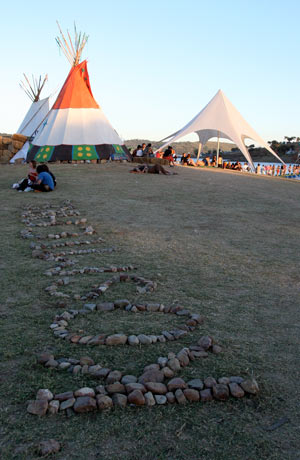
|
At the 2008 Boom, held August 11-18, Erowid provided a psychoactive drugs information booth, staffed by Jon and Sylvia, with the help of volunteers Pedro and Zariat. We looked forward to hearing what sort of questions festival attendees might have over the course of the week, as well as posing our own questions to such a varied crowd, since dozens of countries were represented at the gathering. Jon had attended the Boom twice before as a speaker, so he had a good sense of what to expect from the event.
We were picked up at the Lisbon airport by Pedro, who gifted us with a bottle of wine (for which Portugal is renowned) and took us on a tour of the city. Pedro is a pharmacy student at a Lisbon university, and we picked his brain a bit about his country's illicit drug culture. We were aware that Portugal's laws regarding the possession of small "personal use" amounts of prohibited drugs were fairly liberal; Pedro confirmed that this was true and provided some specifics. He also filled us in on the cannabis scene. The finest hash is referred to as "Pakistani" and average quality is "Moroccan"; however, it all reportedly comes from Morocco. We remarked that a similar situation exists on the West Coast of the United States, where brown or seed-containing weed is occasionally called "Mexican" even if it didn't originate from that country. Pedro related that lower-quality hash in Portugal is sometimes adulterated with assorted "extenders" (there are rumors of wax and shoe polish). He also explained that cannabis buds are rarely sold in Portugal, although a few people grow plants for personal use. Over the course of the week at Boom, we found Pedro to be friendly and helpful, eager to both learn and to share information.
Erowid at Boom
Our booth was located within the Kosmicare cluster, an evolution of Sandra Karpetas' Ground Central Station project, which began at Boom as a small psychedelic first-aid dome. Having viewed its humble beginnings in 2002, and volunteered as a facilitator in the slightly larger CosmiKiva tent incarnation of 2004, Jon was particularly impressed by the expansion of Kosmicare this year. Led by psychologist David Lameiras in consultation with Karpetas and a strong team of volunteers, many of whom drew experience from previously working at Boom, the Burning Man Sanctuary project, and/or other gatherings, Kosmicare exceeded our expectations and set a new standard for what is possible with psychedelic crisis support at festivals.The Booth
Situated a stone's throw from the main Kosmicare dome, our information table featured a laptop loaded with the Erowid website and a few reference books, so that we could help people seek answers to their questions. We shared a teepee with two European risk reduction groups. Portugal's Check-In provided printed flyers and pamphlets with an assortment of basic information about common recreational drugs. They also distributed earplugs, condoms, personal-use insufflation straws, and spray-mister bottles. But from an Erowid perspective, the highlight of the event was witnessing the on-site thin layer chromatography (TLC) drug testing conducted by our other teepee-mates, the Spanish organization Energy Control (see Energy Control: TLC and Other Risk Reduction Approaches, Erowid Extracts. Nov 2008;15:16-17). This service permitted festival-goers to learn more about substances they were considering ingesting. In some cases the test confirmed a substance's identity, while in other cases the test indicated that a substance had been misidentified. In those situations where a substance was adulterated, the test could often provide the identity of the adulterants.
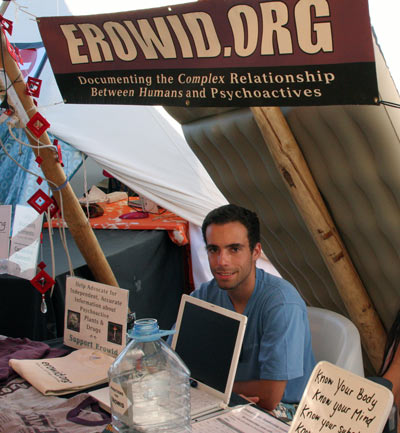
|
"What do you know about LSD-17?"
Visitors' questions frequently transformed into short experience reports, where we got to ask questions of the person giving the report. While illuminating in some respects, these interactions reinforced an underlying reality of working on the Erowid project: many questions related to psychoactive drugs are complex, difficult to answer definitively, and they often require deeper research, consultation with a medical professional, or some degree of speculation.A few questions we got were puzzling. For example, where did the idea to ask about "LSD-17" originate from? But other than the occasional unusual question, people generally were interested in practical things, like the time until onset, dose, and length of action for various drugs.
One woman initially inquired, half in jest, "Can I ask you about anything and you'll know the answer?" Variations of this question were repeated throughout the week, pointing to a common sentiment: the desire for certainty. She went on to describe that she takes paroxetine (Paxil) for depression, and she experiences a terrible comedown following her MDMA consumption. She was wondering whether she should quit taking MDMA. We described that SSRI drugs generally attenuate the effects of psychedelics, but we also looked on the site for specifics related to interactions between Paxil and MDMA. This helped remind us to discuss issues such as potential mood disruption in the days following MDMA use, which can be a more serious problem for those already suffering from depression. It is easy to forget such points when answering diverse questions off the cuff, which is one reason why having access to the Erowid website is so valuable.
One of the more surprising exchanges was with a French woman who worried that if she tongue-kissed her boyfriend several hours after he had taken LSD sublingually, she might get unwanted LSD effects. Through talking with her, we learned that a "common" rumor in her peer group is that you shouldn't pet a dog if you're on LSD, because this will transfer the LSD effects to the dog!
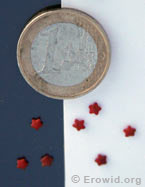
|
The Persistence of Myth
The "problem child" at Boom was a red star-shaped microdot swathed in speculation and frequently sold as mescaline. This microdot was also hawked as LSD and less commonly as "2C-B", "MDMA", or a "DOx compound". After the festival, we even located an image of one of these stars misidentified as 2C-T-7 on Wikipedia.Early in the week a sample was tested via TLC, and it was identified unambiguously as LSD. In at least one case where the correct identity of the substance was known, it was reported as containing "160-170 µg" per star. A Dutch visitor who supported the substance's identity as LSD claimed that two tablets had been quantitatively tested in a lab in the Netherlands: one was 68 µg and the other 72 µg.
While no one reported how much they were charged for a dose of red star "mescaline", other examples of prices for this microdot included one as "DOx" for €10 (about $13.50 USD), one as "MDMA" for €9, and seven as LSD for €50.
The idea that these microdots were mescaline was so widespread and persistent that Energy Control posted flyers at their booth explaining that they were actually LSD. Erowid has busted the myth of mescaline microdots before in the article Myth Debunking: Mescaline in Microdots (Erowid Extracts, May 2001;1:10), so we were well prepared for handling the topic. But we were less prepared for how strongly people wanted to believe that it was possible to fit an active dose of mescaline in a microdot! One dealer of dots presented the theory that the mescaline could fit into such a tiny tablet through a process of "super compression". Then a couple insisted the tablets had effects that were distinctly different from LSD. And in a truly strange story confounding the issue, a man described how he knew "over 100" people who took the red stars and just went to sleep.
All of this is a testament to the power of the mind and the complex recipe of dose, set, and setting. Lacking basic information about what constitutes an active dose of mescaline, a person is susceptible to the sales practices of an unscrupulous or uninformed dealer looking to make a buck. In a worst-case scenario, folks buying "substance A" with expectations of obtaining "substance B" might find themselves in dangerous or unpleasant situations. Fortunately, with LSD sold as mescaline, the psychedelic properties of both substances are similar enough that consumers would likely have an experience that was roughly what they expected.
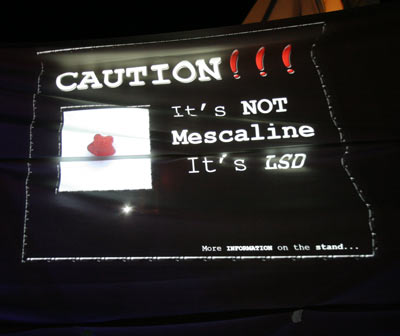
Photo by Jon Hanna |
More Test Results
Aside from misrepresented mescaline, Energy Control's analyses showed that there was fake and adulterated MDMA and cocaine on site as well. While 87% of the crystalline MDMA and 71% of the MDMA tablets available were found to be pure, only 12% of the putative cocaine tested had cocaine as its sole psychoactive ingredient, and 37% contained caffeine and lidocaine, with no cocaine at all. Of the forms of LSD submitted, 79% was blotter, 15% was liquid, and 6% was microdot. Everything sold as LSD that was analyzed actually contained LSD. Other samples obtained at the event tested positive for 2C-B, amphetamine, ketamine, 4-OH-MET, DMT, DPT, methylone, 4-Acetoxy-DMT, DOC, AMT, bromo-dragonfly, and mescaline. (Yes, some real mescaline actually did show up in one sample of powder, although it had been cut with an unidentifiable adulterant.) Risk Reduction Worldwide
Aside from the opportunity to learn about the approach taken by Energy Control, we interacted with representatives from a few other risk reduction groups ("risk reduction" seems to be preferred to the term "harm reduction" among those we spoke with), giving us a tantalizing taste of these non-English drug information efforts. We learned about a (new to us) harm reduction gadget that some groups distribute: a booklet of papers that can be rolled up to make disposable personal-use sniffing straws (since sharing straws can potentially spread Hepatitis C, as well as cold and flu germs). A Czech group working under the umbrella of Centrum Protidrogové Prevence a Terapie receives 90-95% of its funding from the government. Active for the last five years, this group sees a lot of alcohol and methamphetamine use at parties, and some MDMA and LSD. They offer Marquis reagent testing and distribute earplugs and info pamphlets. Check-In staffers explained that harm reduction is currently being promoted in Portugal by the government. They would like to be doing TLC, and have applied for a grant from the Ministry of Health. It was heartening to hear about actual and potential government funding for risk reduction initiatives in other countries, since such support is largely lacking in the United States. Erowid would love to learn more about foreign information dissemination organizations, and link to such groups.

|
A Safe Space
While all this discussion and testing was happening in the teepee, next door in the main Kosmicare dome, the rubber was hitting the road. Festival attendees having difficult psychedelic trips found their way into the care of dedicated and skilled volunteers who created a safe zone for these people to navigate their challenging mind states.The enormous dome was well-appointed with comfortable areas for people to lie down, reorient, and recover. A psychiatrist was on call and at least one psychologist was usually on site. The dome could support a large number of people, and an annex teepee nearby was specifically dedicated for particularly intense cases. If a visitor was agitated enough to disrupt others in the main dome, this person was moved to the teepee where he or she could get more focused attention in privacy.
What distinguished Kosmicare from other festival crisis support that we've seen was the third degree of safe space that it offered. If a person who arrived at the dome was having a strong experience and his or her belief system seemed compatible with a shamanic context, then volunteers could take this person to a nearby structure--a cross between a Native American kiva and a teepee--designed to support a spiritual journey. Built from straw bales plastered with adobe, this private space for individual journeying stayed unusually cool and dark even during the sunniest of days. The lighting created a moody, dramatic context that contrasted with the typical festival setting.
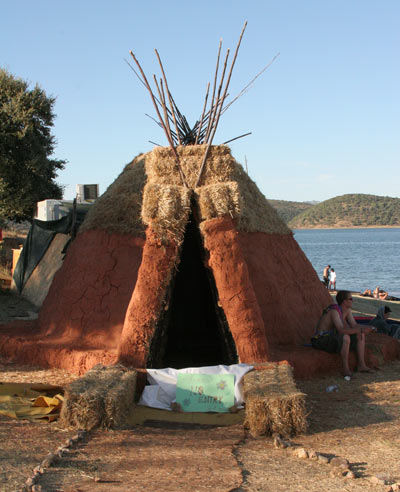
Photo by Jon Hanna |
Major Health Issue
The largest failings of the Boom Festival, both in 2008 and in years past, have been related to food poisoning. Although we brought our own pure drinking water and hand sanitizer, we were both among the hundreds--if not thousands--of people who got sick over the course of the week. Unless you had brought your own, hand sanitizer and soap were scarce, and sinks for washing were few and far between. The event was about 20% oversold, which impacted an already strained infrastructure. Combine this situation with a multitude of flies swarming around the composting toilets and food stalls, and illness brought on by contaminated food was dismayingly common.Applied Psychonautics
In the middle of the week, we stepped away from our booth to facilitate a workshop at the Liminal Village, which hosted a series of lectures, films, and a visionary art gallery. Titled "Applied Psychonautics: Cultivating Skeptical Thought", we planned to talk about practical approaches for dealing with psychoactive drugs, raise questions about common misconceptions and myths, and stimulate discussion. Due to the types of questions that we had been getting earlier in the week, and because English was not the native language for most of those in attendance, we instead took a "back to basics" approach with our presentation.About 200 people showed up for our workshop. We focused on the Erowid motto, "Know Your Body, Know Your Mind, Know Your Substance, Know Your Source", as well as other critical-thinking principles. At one point we decided to ask about changa (or xanga), a smokable psychoactive preparation that we had first heard about a few days earlier (see Got Changa?, Erowid Extracts. Nov 2008;15:18-19). We were curious if the crowd knew anything about this substance, and a workshop attendee provided everyone with some valuable data. The topic was revisited in a funny way later in the week, when someone visiting the Erowid booth told us that he had heard we had given a talk all about changa! No, we did not give a talk about changa.

Photo by Jon Hanna |
"Erowid is my Bible"
Two different people made this bold proclamation over the course of our week at the festival, and countless others had kind words to say, thanking us for Erowid's existence. It was heartening to hear how useful people find the Erowid site. However, the general enthusiasm for psychoactive drug consumption coupled with the lack of basic knowledge we observed among many festival-goers, reinforced how important it is for Erowid--while staying abreast of new research and keeping the website updated--to develop documentation that explores fundamental principles regarding how to best relate to psychoactive drugs, while stimulating visitors to think critically and ask good questions.Links #
- Energy Control (Spain)
- Check-In (Portugal)
- Boom Festival


